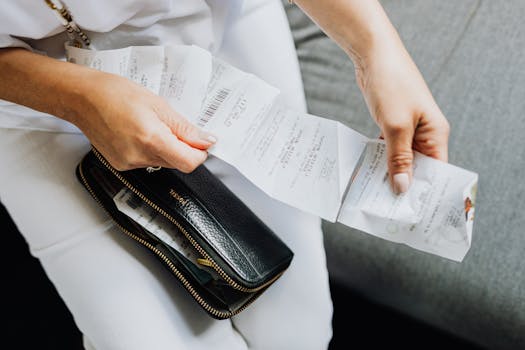Personal finance
How to Organize Your Bills for a Stress-Free Month
Organize bills confidently, simplify bill payment, and stop late fees with clear monthly routines, tracking tips, and a straightforward system—take control of your finances now.
Advertisement
The stack of monthly bills on the kitchen counter tends to grow as the days pass, turning what should be routine tasks into a source of stress. Sometimes it feels like bills arrive out of sequence and disappear just as quickly, making it easy to overlook something important. Not everyone is naturally organized, but anyone can learn systems to handle this challenge.
Feeling in control of your household finances means knowing exactly where every dollar is headed and when it’s leaving your account. That’s why focusing on strategies to organize bills is worthwhile. Streamlined handling minimizes missed payments and month-end surprises, bringing financial stability within reach for everyone.
This article explores step-by-step methods to organize bills, stop last-minute scrambles, and set routines that save time and money. Read on for examples, checklists, and decision aids you can implement immediately for a more confident financial month.
Establish a Reliable Bill Management Hub
Setting up a central place for all financial paperwork immediately lowers the chances of missed payments. Creating a dedicated spot, physical or digital, makes it easy to organize bills and retrieve documents fast.
Start by choosing a visible and convenient location: a clearly labeled folder on your computer, a stand-alone binder, or a small basket near your home workspace all work. Consistency is more important than complexity.
Create a Home Command Center for Paper Bills
Keeping all incoming paper bills in one area—such as a wall-mounted file or accordion folder—means you’re less likely to forget about them. Each new bill goes in when you open your mail.
List each due date on a master calendar as you file. This step links the physical act of sorting with proactive payment planning, so no paperwork gets buried under junk mail or homework assignments.
Set a recurring reminder to check the folder twice a week. If it helps, place a sticky note with “organize bills today” near the home’s primary entrance as an extra nudge.
Transition Digital Statements Into an Easy Reference System
Download all digital bills to a dedicated desktop folder labeled by category—utilities, internet, subscriptions—immediately after you receive them. Move old PDFs to an “archived” subfolder.
Add a prefix with the due date to each file name for simple sorting, like “2024-07-14_WaterBill.pdf.” That way, at a glance, you’ll know what bills are upcoming. This keeps your digital system tidy and actionable.
Create an automatic email filter or label that collects all email bill notices in a single place. Once a week, scan this folder and check off payments in your bill-tracking sheet.
| Bill Category | Where It Arrives | Filing Method | Next Step |
|---|---|---|---|
| Utilities | Email & Mailbox | Physical folder or PDF folder | Log due date on calendar, prep auto payment |
| Credit Cards | Email label and digital backup | Schedule payment, reconcile charges | |
| Subscriptions | Subscription tracker spreadsheet | Review renewal/expiration dates | |
| Insurance | Mailbox | Binder or envelope by type | Note quarterly/annual due date, flag changes |
| Rent/Mortgage | Email & Portal | Portal login list, print statement | Confirm payment receipt, file copy |
Prioritize Bills With a Due Date Sequence
Listing each bill in due-date order makes payment schedules predictable and cuts down on missed or late fees. By handling bills in a specific sequence, you reduce stress and gain confidence.
A wall calendar or spreadsheet—either digital or paper—works well. Write each payment down on the day you receive the bill and check it again every Sunday as a habit.
Create a Consistent Payment Routine
Link every bill to a particular weekday. For example, schedule all payments every Saturday morning over coffee. Consistency turns bill-paying into another manageable weekly task.
- Batch payments by week: Handle bills due in the next seven days together, so you never scramble to chase down last-minute notices.
- Set calendar alerts: Schedule payment reminders for each bill three days before it’s due, giving you time to organize bills and adjust plans if income is late.
- Divide and conquer: If you share financial duties, assign who pays what, and verify together before mid-month to ensure nothing falls through the cracks.
- Mark paid dates on your tracker: Check off every bill the moment it’s paid—seeing completed tasks boosts motivation and reinforces good habits.
- Use a payment checklist: Print out a fresh monthly list of recurring bills and mark them off as you go. Visual cues keep progress clear and reduce anxiety.
Getting ahead of deadlines builds a reliable pattern. Each checkbox marked “paid” means one less thing to worry about next month.
Balance Automatic and Manual Payments
Automate only fixed, predictable charges like subscriptions and utilities. Manual payments are better for bills that vary, like credit cards or medical expenses, to avoid overdrawn accounts.
- Auto-schedule rent: Knowing your biggest expense is handled lets you focus on smaller bills without fear of missing the most important payment.
- Monitor auto-pay withdrawals: Set up account alerts to notify you the day a payment is taken to avoid accidental overdrafts and keep cash flow on track.
- Manually review variable bills: Always double-check statement totals and due dates before paying, so no incorrect charges slip through unnoticed.
- Update payment info proactively: When a card expires, update it on every auto-pay bill at once; set a reminder for card renewal month so auto-pay doesn’t fail.
- Keep a back-up payment method: For manual bills, list an alternate account to avoid payment issues when your primary method is unavailable.
Striking the right balance between automation and attentive manual review gives you peace of mind and stronger control over your bill process.
Fine-Tune Your Tracking Methods for Clarity
Using a robust yet simple tracking method lets you organize bills at a glance and stay on top of every due date, amount, and status without second-guessing yourself.
Pick a process that fits your lifestyle. For some, a physical ledger brings clarity. Others thrive with a digital spreadsheet. Tools are less important than consistency—pick one and use it every month.
Build an At-Home Bill Tracker for Quick Reference
Reserve a page for each month. List every recurring bill: rent, water, credit card, trash, and more. Columns include due date, amount, and payment status.
Color-code payments: Green means paid, yellow is pending, and red is overdue. This visual system cuts confusion and highlights where extra attention is needed before the month ends.
Every Saturday, update the sheet. Grab any new bills and compare with last month’s copy, catching changes in charges or frequency right away before you miss a detail.
Organize Bills With a Custom Digital Dashboard
Make a simple spreadsheet: List bills vertically, months horizontally, with checkboxes for payment confirmation. Add formulas to total monthly expenses so you spot trends over time.
Use cloud storage solutions—like Google Sheets—so you can update your tracker from your phone at the store or on the go. Convenience is key for a sustainable system.
If you prefer reminders, use calendar integrations to link your spreadsheet: set pop-ups or email prompts 48 hours before each due date for faster reactions to upcoming bills.
Troubleshoot Common Bill Payment Obstacles
Unexpected expenses, misplaced statements, or fluctuating income can derail any well-planned system. Creating backup plans ensures you’ll organize bills successfully even on challenging months.
Build flexibility by identifying personal stressors—whether it’s travel, illness, or busy school months—and plan for those hurdles in advance to keep payments on track regardless.
Reduce Missed Payments by Prepping for Life’s Disruptions
Keep a “bill buffer” account: add a month’s worth of average bills to a secondary savings account. Use only for bill emergencies, never for daily spending temptations like takeout.
Pair up with a partner, roommate, or close friend. Commit to a monthly “bill check-in”—five minutes, first Sunday of the month, confirming all incoming statements and due dates together.
If a bill goes missing or a due date is missed, contact the provider directly the next business day and request a payment arrangement or a late-fee waiver. Addressing it immediately limits the penalty.
Adapt When Income Isn’t Predictable
When paychecks come on uneven dates, list your core bills in order of urgency: housing, utilities, insurance, followed by discretionary expenses. Mark high-priority bills with a star on your calendar.
Set aside at least part of every incoming payment—20% if possible—into a dedicated “must-pay-bills” account as soon as you get paid to ensure key bills are always covered first.
If you run short, call providers before the due date. Many will work out payment extensions or payment plans if you clearly state, “I need extra time this month.” Following up quickly shows you’re responsible and helps keep accounts in good standing.
Your Path to a Predictable Bill Cycle
Building a consistent routine to organize bills transforms financial frustration into a smoother, more confident experience. Each step—establishing a hub, sequencing due dates, and optimizing tracking—provides concrete control over your finances month after month.
People don’t wake up naturally organized; it’s a skill built with smart habits, tailored routines, and accessible tools that fit your lifestyle. Addressing obstacles as they come keeps your monthly bill cycle predictable, even as life throws surprises your way.
Making bill organization a priority pays off in reduced stress, clearer finances, and freed-up mental energy for what matters most. Apply one suggestion from this guide today and see how it paves the way for a more comfortable month ahead.





